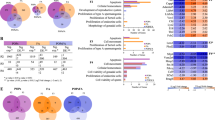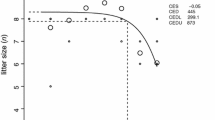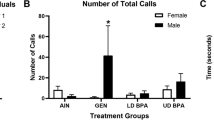Abstract
Chromium(III) picolinate, [Cr(pic)3], is a commonly used nutritional supplement in humans, which has also been approved for use in animals. Health concerns have arisen over the use of [Cr(pic)3]. At high [Cr(pic)3] doses, developmental toxicity tests in female mice have shown a higher litter incidence of split cervical arch in exposed fetuses, but this was not consistently reproducible. In the current study, male CD-1 mice were used to further assess the potential for reproductive or developmental toxicity. Four weeks prior to mating, the males were fed a diet providing 200 mg/kg/day [Cr(pic)3] for comparison with untreated controls. Females were not treated. Each male was mated with two females, which were sacrificed on gestation day 17, and their litters were examined for adverse effects. Mating and fertility indices were not significantly altered by treatment. Male exposure to [Cr(pic)3] also had no effect on prenatal mortality, fetal weight, or gross or skeletal morphology. These results suggest that paternal dietary exposure to chromium(III) picolinate has little potential for adverse reproductive effects, even at exposure levels considerably higher than expected human exposures from nutritional supplements (1 mg of Cr per day or less).
Similar content being viewed by others
References
Vincent JB (2010) Chromium: celebrating 50 years as an essential element? Dalton Trans 39:3787–3794
Di Bona KR, Love S, Rhodes NR et al (2011) Chromuim is not an essential trace element for mammals: effects of a “low chromium” diet. J Biol Inorg Chem (in press)
National Research Council (1980) Recommended dietary allowances, 9th ed. Report of the Committee on Dietary Allowances, Division of Biological Sciences, Assembly of Life Science, Food and Nutrition Board, Commission on Life Science, National Research Council. National Academy Press, Washington, D.C
Anderson RA, Kozlovsky AS (1985) Chromium intake, absorption and excretion of subjects consuming self-selected diets. Am J Clin Nutr 41:1177–1183
Balk E, Tatsioni A, Lichtenstein A et al (2007) Effect of chromium supplementation on glucose metabolism and lipids: a systematic review of randomized controlled trials. Diab Care 30:2154–2163
Stearns D, Wise SJ, Patierno S et al (1995) Chromium(III) picolinate produces chromosome damage in Chinese hamster ovary cells. FASEB J 9:1643–1648
Stearns D, Silveira S, Wolf K et al (2002) Chromium(III) tris(picolinate) is mutagenic at the hypoxanthine (guanine) phosphoribotransferase locus in Chinese hamster ovary cells. Mutat Res 513:135–142
Stearns D, Belbruno J, Wetterhahn K (1005) A prediction of chromium(III) accumulation in humans from chromium dietary supplements. FASEB J 9:1650–1657
Whittaker P, San R, Clarke J et al (2005) Mutagenicity of chromium picolinate and its components in Salmonella typhimurium and L5178Y mouse lymphoma cells. Food Chem Toxicol 43:1619–1625
Speetjens JK, Collins RA, Vincent JB et al (1999) The nutritional supplement chromium(III) tris(picolinate) cleaves DNA. Chem Res Toxicol 12:483–487
Gudi R, Slesinski R, Clarke J et al (2005) Chromium picolinate does not produce chromium damage in CHO cells. Mutat Res 587:140–146
Slesinski R, Clarke J, San R et al (2005) Lack of mutagenicity of chromium picolinate in the hypoxanthine phosphoribosyltransferase gene mutation assay in Chinese hamster ovary cells. Mutat Res 585:86–95
Coryell V, Stearns D (2006) Molecular analysis of hprt mutations induced by chromium picolinate in CHO AA8 cells. Mutat Res 610:114–123
Bailey MM, Boohaker JG, Sawyer RD et al (2006) Exposure of pregnant mice to chromium picolinate results in skeletal defects in their offspring. Birth Defects Res B 77:244–249
Bailey MM, Jernigan PL, Townsend MB et al (2008) Comparison of the potential for developmental toxicity of prenatal exposure to two dietary chromium supplements, chromium picolinate and [Cr3O(O2CCH2CH3)6(H2O)3]+, in mice. Birth Defects Res B 83:27–31
Bailey MM, Bohaker JG, Jernigan PL et al (2008) Effects of pre- and postnatal exposure to chromium picolinate and picolinic acid on neurological development. Biol Trace Elem Res 124:70–82
Hepburn DDD, Xiao J, Bindom S et al (2003) Nutritional supplement chromium picolinate causes sterility and lethal mutations in Drosophila melanogaster. Proc Natl Acad Sci USA 100:3766–3771
Stallings DM, Hepburn DDD, Hannah M et al (2006) Nutritional supplement chromium picolinate generates chromosomal aberrations and impedes progeny development in Drosophila melanogaster. Mutat Res 610:101–113
Press R, Gellar J, Evans G (1990) The effects of chromium picolinate on serum cholesterol and apolipoprotein fractions in human subjects. West J Med 152:41–45
Chakov NE, Collins RA, Vincent JB et al (1999) A re-investigation of the electronic spectra of chromium(III) picolinate complexes and high yield synthesis and characterization of Cr2(m-OH)2(pic) .4 5H2O (Hpic = picolinic acid). Polyhedron 18:2891–2897
Webb G, Byrd R (1994) Simultaneous differential staining of cartilage and bone without glacial acetic acid. Biotech Histochem 69:181–185
Stout MD, Nyska A, Collins BJ et al (2009) Chronic toxicity and carcinogenicity studies of chromium picolinate monohydrate administered in feed to F344/N rats and B6C3F1 mice for 2 years. Food Chem Toxicol 47:729–733
Research Triangle Institute, Project Report (2002) [14C]Chromium picolinate monohydrate: disposition and metabolism in rats and mice, submitted to National Institutes of Environmental Health Sciences
EFSA panel on Food Additives and Nutrient Sources added to Food (ANS) (2010) Scientific opinion on the safety of chromium picolinate as a source of chromium added for nutritional purposes to foodstuff for particular nutritional uses and to foods intended for the general population. EFSA J 8(12):1883
Acknowledgments
F.B. and C.G. were supported in part by NSF REU grant (CHE 0647789) to J.B.V. and Stephen A. Woski.
Conflict of Interest Statement
J.B.V. is the inventor or co-inventor of four patents on the use of Cr3, [Cr3O(O2CCH2CH3)6(H2O)3]+, as a nutritional supplement or therapeutic agent.
Author information
Authors and Affiliations
Corresponding author
Rights and permissions
About this article
Cite this article
McAdory, D., Rhodes, N.R., Briggins, F. et al. Potential of Chromium(III) Picolinate for Reproductive or Developmental Toxicity Following Exposure of Male CD-1 Mice Prior to Mating. Biol Trace Elem Res 143, 1666–1672 (2011). https://doi.org/10.1007/s12011-011-9002-4
Received:
Accepted:
Published:
Issue Date:
DOI: https://doi.org/10.1007/s12011-011-9002-4




